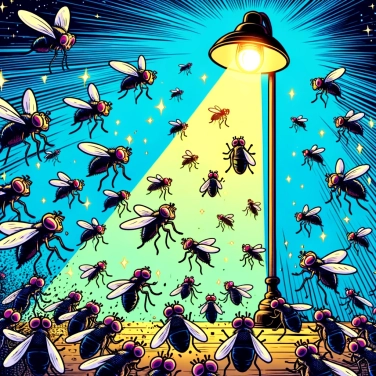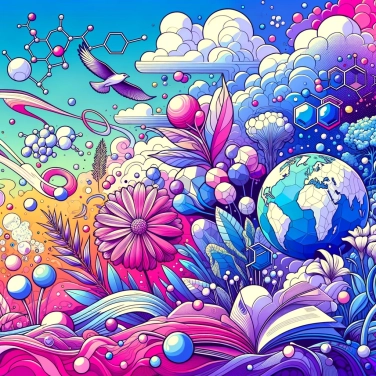Flies are attracted to light because of their positive phototaxis. This means that they are instinctively drawn to light and have evolved this way to help them navigate and orient themselves in their environment.

Science has recently pointed to phototaxis, a biological phenomenon that drives certain insects, like flies, to dash straight towards a light source. Specifically, these creatures naturally use sunlight or moonlight as navigational cues, maintaining a constant angle while moving. With the advent of artificial lamps, their orientation systems become completely confused: instead of flying straight calmly, they end up endlessly circling around light bulbs. Recent research also suggests that their eyes, composed of thousands of facets, are particularly sensitive to certain types of light (notably UV or bluish light). These lights strongly stimulate their nervous system, irresistibly capturing their attention.
Flies use light as a fixed visual reference to maintain a stable trajectory while flying. Their compound eyes capture light rays and transmit the information directly to their brain, allowing them to intuitively adjust their flight towards the light source. The problem is that in nature, this light mainly comes from the sun or the moon, which are very distant objects, making it easy for the fly to navigate. But with our very close artificial lamps and bulbs, it completely disrupts their system: the fly then circles around trying to keep the light at a certain angle, which is why we often observe those strange dances under light fixtures. In short, this phenomenon called phototaxis is at the heart of their orientation mechanisms: they instinctively move towards a light source, unable to help themselves.
Flies are particularly attracted to short-wavelength light sources such as ultraviolet (UV) light or blue light. This type of light is very visible to them and attracts them much more than warm tones like yellow or red lights. Fluorescent tubes, halogen lamps, or certain white LED lights produce a significant amount of UV, explaining why so many insects swarm around our light fixtures in the evening. In contrast, reddish or orangish lighting rarely attracts these insects, as their visual perception is primarily sensitive to short wavelengths. That's why insect traps generally use bluish or violet lights to maximize their effectiveness.
A striking study showed that flies placed in a dark environment with a single light source quickly moved towards it, clearly confirming their light preference. Researchers tested different wavelengths (colors), discovering that flies significantly preferred ultraviolet light over red light, which was less attractive to them. In the laboratory, some scientists even placed flies in a light tunnel: they flew in a zigzag pattern while constantly maintaining a precise angle relative to the light, demonstrating their simple yet effective way of navigating based on light cues. Another clever experiment used intermittent lights to study the visual sensitivity of flies, revealing that they are particularly attracted to lights that blink at certain frequencies. These tests clearly demonstrate that fly vision is calibrated to react in a natural and almost automatic manner when confronted with a light cue.
In insects, attraction to light varies greatly. Flies cannot resist it: often, they endlessly orbit around a bulb without being able to detach, which is called a positive phototaxis. But look at the moths — they are even more obsessed with bright lights, blindly following a lamp until they burn their wings. In contrast, some insects, like cockroaches, flee from the light: for them, it's a negative phototaxis. They much prefer a nice dark area where they can remain undetected. Bees and daytime butterflies, on the other hand, react differently depending on the wavelengths; for example, they primarily distinguish UV light to identify their favorite flowers. Flies are easily trapped by artificial light, but they are not the only ones; each insect species evolves with its own strategy in response to light according to its habits and natural environment.
In many nocturnal insects, including flies, positive phototaxis refers to their attraction to light, while negative phototaxis refers to their tendency to avoid it.
The UV lamps used in insect traps attract flies because they emit a wavelength very close to that of the natural light reflected by flowers, fruits, or the surface of water.
Flies have compound eyes made up of thousands of small facets called ommatidia, giving them a panoramic vision of nearly 360 degrees and allowing for excellent motion perception.
Contrary to a common belief, it is not the heat emitted by light bulbs that attracts flies, but mainly their intense light, especially when it emits ultraviolet rays.
Yes, this can decrease their survival rate. When flies become obsessed with an artificial light source, they become more fatigued, are at a greater risk of being easy prey, or injure themselves by coming into contact with hot or electrified surfaces.
Although many flies are attracted to light, there are species that are completely indifferent to it. Generally, nocturnal or crepuscular flies are more attracted than strictly diurnal species.
In general, flies are particularly attracted to ultraviolet (UV) and blue light, as these colors are very visible to their eyes. Conversely, they are less sensitive to yellow or red light.
Yes, UV light traps can be effective in reducing the number of flies and other flying insects. However, they are not effective for all species and can even attract additional insects to a given area if misused.
Flies use natural light to navigate. When they encounter an artificial light source (lamp, bulb), they become disoriented and end up flying around it, drawn to a light they mistake for a natural reference point like the moon or the sun.

No one has answered this quiz yet, be the first!' :-)
Question 1/5